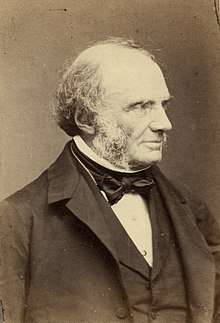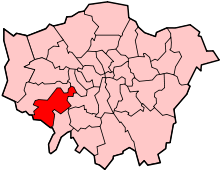Pembroke Lodge, Richmond Park
Pembroke Lodge is a Grade II listed[1] Georgian mansion in Richmond Park in the London Borough of Richmond upon Thames. It is located on high ground with views across the Thames valley to Windsor and Surrey. It has 11 acres (4.5 ha) of beautifully landscaped grounds, including King Henry's Mound from which there is a protected view of St Paul's Cathedral in the City of London. The grounds also include memorials to the 18th-century poet James Thomson and the 20th-century rock-and-roll singer and lyricist Ian Dury.
| Pembroke Lodge | |
|---|---|
 Pembroke Lodge | |
| Location | Richmond Park, TW10 5HX (London Borough of Richmond upon Thames), England, UK |
| Area | Eleven acres (45,000 m²)of surrounding grounds |
| Built | mid-18th century |
| Restored | 2005 |
| Restored by | The Royal Parks and the Hearsum Family |
| Architectural style(s) | Georgian |
| Governing body | Crown Estate |
Listed Building – Grade II | |
| Official name: Pembroke Lodge | |
| Designated | 25 May 1983 |
| Reference no. | 1263437[1] |
The building is of historical interest, having been the residence of the British prime minister Lord John (later, Earl) Russell and the childhood home of his grandson, the philosopher Bertrand Russell. GHQ Liaison Regiment ("Phantom") was also based there during the Second World War. Pembroke Lodge is part of the Crown Estate and is currently privately run as a catering facility and a conference and wedding venue on a long lease from The Royal Parks. It also houses a heritage charity, The Hearsum Collection.
History
The Lodge is first mentioned in 1754, when it was a one-roomed cottage occupied by a molecatcher. He was employed to eradicate molehills that were impeding the sport of deer hunting. The cottage was enlarged to become a house with four principal rooms and was renamed Hill Lodge.[2]
The Lodge was granted to Elizabeth Herbert, Countess of Pembroke and Montgomery, a "close friend" of King George III, at her request in 1787. Between 1788 and 1796 she extended the building, to a design by Sir John Soane,[3] to form the entire Georgian wing and part of the north wing. She died, aged 93, at Pembroke Lodge in 1831.[4] After the Countess of Pembroke's death the Lodge was occupied by William Hay, 18th Earl of Erroll.[4]
In 1847, Queen Victoria granted the Lodge to Lord John Russell,[5] then Prime Minister, who conducted much government business there and entertained Queen Victoria, foreign royalty, aristocrats, writers (Dickens, Thackeray, Longfellow, Tennyson) and other notable people of the time, including Garibaldi. Lord John was much taken with the Lodge – "an asset that could hardly be equalled, certainly not surpassed in England". Earl Russell (as he had become) died there on 28 May 1878; Fanny, his second wife, in 1898. Their daughter Lady Agatha Russell left a memorial, still standing in the rose garden: "Pembroke Lodge 1847–1902 — In loving memory of my Father and Mother, Lord and Lady Russell and of our supremely happy home at Pembroke Lodge".
Lord John Russell's grandson, Bertrand Russell, the philosopher and mathematician, grew up there between 1876 and 1894. At Pembroke Lodge, he wrote, "I grew accustomed to wide horizons and to an unimpeded view of the sunset".[6]
From 1903, until her death there in February 1929,[7] Pembroke Lodge was tenanted by Georgina, Dowager Countess of Dudley, a close friend of Queen Alexandra.[8] There is a headstone in Pembroke Lodge's gardens to the grave of her dog, Boy, who died in 1907.[9]
From 1929 to 1938, John Scott Oliver, a wealthy industrialist, lived at Pembroke Lodge.[2] During World War II, the GHQ Liaison Regiment (also known as Phantom) established its regimental headquarters nearby at The Richmond Hill Hotel,[10] with its base (including the officers' mess and billet) at Pembroke Lodge.[11] Some of the members of the squad went on to become privy councillors, law lords, judges, MPs, a commissioner of the Metropolitan Police (Sir Robert Mark)[12] and actors – including David Niven, who remarked in a letter, "these were wonderful days which I would not have missed for anything".[13] After World War II, Pembroke Lodge became a government-run tea room.[2]
Current use
Now in private hands and restored to its former architectural glory,[14] Pembroke Lodge is open to the public for refreshments, weddings and conferences.[15] Pembroke Lodge is also the home of The Hearsum Collection, a registered charity[16] that collects and preserves the heritage of Richmond Park and is seeking to build a new purpose-built heritage centre to provide full public access to its holdings.[17][18][19][20]
Notes and references
- Historic England. "Pembroke Lodge (1263437)". National Heritage List for England. Retrieved 16 September 2016.
- Hearsum, Daniel. "Pembroke Lodge History". Pembroke Lodge. Archived from the original on 12 March 2016. Retrieved 28 February 2016.
- McDowall, David (1996). Richmond Park: The Walker's Historical Guide. ISBN 0952-78470-X.
- Malden, H E (ed.) (1911). "Parishes: Richmond (anciently Sheen)" in A History of the County of Surrey: Volume 3, British History Online, pp. 533–546. Accessed 14 August 2015.
- Fletcher Jones, Pamela (1972). Richmond Park: Portrait of a Royal Playground. Phillimore & Co Ltd. p. 41. ISBN 0-8503-3497-7.
- Russell, Bertrand (1967). The Autobiography of Bertrand Russell 1872–1914. London: George Allen & Unwin Ltd. p. 19.
- "Death of Georgina, Lady Dudley: A Great Lady of the Victorian Age". Glasgow Herald. 9 February 1929.
- "Georgina Lady Dudley: A Great Lady and Her Work". The Times. The Times Digital Archive. 4 February 1929. p. 11.
- "The dog, the cookbook and the society beauty". The Collection. The Hearsum Collection. Retrieved 28 October 2015.
- Osborne, Mike (2011). Defending London: A Military History from Conquest to Cold War. Stroud, Gloucestershire: The History Press.
- Lankester, Max (2011). "History" in Guide to Richmond Park. London: Friends of Richmond Park. p. 91. ISBN 978-0-9567469-0-0.
- Campbell, Duncan (1 October 2010). "Sir Robert Mark obituary". The Guardian. Retrieved 3 October 2012.
- Day, Martyn (3 March 2011). "The Phantom in Richmond Park". St Margarets community website. Retrieved 22 April 2018.
- McDonnell, Colleen (28 October 2005). "Philosophy behind ambitious restoration". Richmond and Twickenham Times. Retrieved 15 June 2013.
- "Time for Tea: Pembroke Lodge, Richmond Park". Surrey Mirror. 11 July 2015. Archived from the original on 15 August 2015. Retrieved 9 September 2015.
- "The Hearsum Collection". Open Charities. 11 June 2014. Retrieved 3 November 2014. Charity registration number 1153010
- The Heritage Pavilion (Video). Richmond Park, London: The Hearsum Collection. 11 November 2014.
- "Our vision for the future". The Hearsum Collection. Retrieved 30 May 2015.
- "Conserving Our Parks' Heritage". The Royal Parks Guild. Retrieved 3 November 2014.
- Wood, Robert (Autumn 2014). "Consultation on new heritage centre". Friends of Richmond Park newsletter: 13.
Further reading
- "A dinner at Pembroke Lodge, 1853". Richmond History: Journal of the Richmond Local History Society. 5: 51. 1984. ISSN 0263-0958.
- Pasmore, Stephen (1990). "The Countess of Pembroke and Pembroke Lodge, Richmond Park". Richmond History: Journal of the Richmond Local History Society. 11: 12–19. ISSN 0263-0958.

